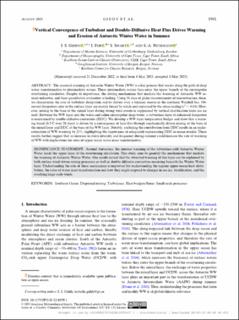| dc.contributor.author | Giddy, I.S. | |
| dc.contributor.author | Fer, Ilker | |
| dc.contributor.author | Swart, Sebastiaan | |
| dc.contributor.author | Nicholson, S.-A. | |
| dc.date.accessioned | 2023-09-14T11:17:34Z | |
| dc.date.available | 2023-09-14T11:17:34Z | |
| dc.date.created | 2023-09-01T10:46:19Z | |
| dc.date.issued | 2023 | |
| dc.identifier.issn | 0022-3670 | |
| dc.identifier.uri | https://hdl.handle.net/11250/3089437 | |
| dc.description.abstract | The seasonal warming of Antarctic Winter Water (WW) is a key process that occurs along the path of deep water transformation to intermediate waters. These intermediate waters then enter the upper branch of the circumpolar overturning circulation. Despite its importance, the driving mechanisms that mediate the warming of Antarctic WW remain unknown, and their quantitative evaluation is lacking. Using 38 days of glider measurements of microstructure shear, we characterize the rate of turbulent dissipation and its drivers over a summer season in the northern Weddell Sea. Observed dissipation rates in the surface layer are mainly forced by winds and explained by the stress scaling (r2 = 0.84). However, mixing to the base of the mixed layer during strong wind events is suppressed by vertical stratification from sea ice melt. Between the WW layer and the warm and saline circumpolar deep water, a subsurface layer of enhanced dissipation is maintained by double-diffusive convection (DDC). We develop a WW layer temperature budget and show that a warming trend (0.2°C over 28 days) is driven by a convergence of heat flux through mechanically driven mixing at the base of the mixed layer and DDC at the base of the WW layer. Notably, excluding the contribution from DDC results in an underestimation of WW warming by 23%, highlighting the importance of adequately representing DDC in ocean models. These results further suggest that an increase in storm intensity and frequency during summer could increase the rate of warming of WW with implications for rates of upper-ocean water mass transformation. | en_US |
| dc.language.iso | eng | en_US |
| dc.publisher | AMS | en_US |
| dc.relation.uri | https://10.5281/zenodo.7957942 | |
| dc.rights | Navngivelse 4.0 Internasjonal | * |
| dc.rights.uri | http://creativecommons.org/licenses/by/4.0/deed.no | * |
| dc.title | Vertical Convergence of Turbulent and Double-Diffusive Heat Flux Drives Warming and Erosion of Antarctic Winter Water in Summer | en_US |
| dc.type | Journal article | en_US |
| dc.type | Peer reviewed | en_US |
| dc.description.version | publishedVersion | en_US |
| dc.rights.holder | Copyright 2023 American Meteorological Society | en_US |
| cristin.ispublished | true | |
| cristin.fulltext | original | |
| cristin.qualitycode | 2 | |
| dc.identifier.doi | 10.1175/JPO-D-22-0259.1 | |
| dc.identifier.cristin | 2171575 | |
| dc.source.journal | Journal of Physical Oceanography | en_US |
| dc.source.pagenumber | 1941-1958 | en_US |
| dc.relation.project | Norges forskningsråd: 294396 | en_US |
| dc.subject.nsi | VDP::Oseanografi: 452 | en_US |
| dc.subject.nsi | VDP::Oceanography: 452 | en_US |
| dc.identifier.citation | Journal of Physical Oceanography. 2023, 53, 1941-1958. | en_US |
| dc.source.volume | 53 | en_US |

